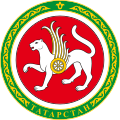Pre-Stalinist Emblems of the Autonomous Soviet Republics
| Autonomous Soviet Republic | Emblem | Main Article | Usage | Republic-specific features | Present-day national coat of arms | |
|---|---|---|---|---|---|---|
| Adjara |  | Emblem of the Adjar ASSR | 1922-1937 | Plants | wheat, grapes |  Coat of arms of Adjara |
| Landscapes, geographic features | Caucasus Mountains | |||||
| Industry | ||||||
| Ornaments | Star and crescent | |||||
| Bashkortostan |  | Emblem of the Bashkir ASSR | 1925-1937 | Plants | wheat |  Coat of arms of Bashkortostan |
| Landscapes, geographic features | ||||||
| Industry | ||||||
| Ornaments | Baroque cartouche | |||||
| Chuvash |  | Emblem of the Chuvash ASSR | 1927-1931 | Plants | wheat |  Coat of arms of Chuvashia |
| Landscapes, geographic features | ||||||
| Industry | gear | |||||
| Ornaments | Chuvash traditional ornaments | |||||
 | 1931-1937 | Plants | wheat, oak, spruce | |||
| Landscapes, geographic features | ||||||
| Industry | ||||||
| Ornaments | Chuvash traditional ornaments | |||||
 | 1937-1978 | Plants | wheat, oak, spruce | |||
| Landscapes, geographic features | ||||||
| Industry | ||||||
| Ornaments | Chuvash traditional ornaments | |||||
 | 1978-1992 | Plant | wheat, oak, fir | |||
| Landscapes, geographic features | ||||||
| Industry | ||||||
| Ornaments | Chuvash traditional ornaments | |||||
| Dagestan |  | Emblem of the Dagestan ASSR | 1921-1927 | Plants | wheat |  Coat of arms of Dagestan |
| Landscapes, geographic features | ||||||
| Industry | ||||||
| Ornaments | Baroque cartouche | |||||
 | 1927-1937 | Plants | vine, maize, wheat | |||
| Landscapes, geographic features | Mount Bazardüzü | |||||
| Industry | gear | |||||
| Ornaments | ||||||
| Mordovia |  | Emblem of the Mordovian ASSR | 1934-1937 | Plants | wheat, spruce, hemp [1] |  Coat of arms of Mordovia |
| Landscapes, geographic features | ||||||
| Industry | ||||||
| Ornaments | ||||||
| Tatarstan |  | Emblem of the Tatar ASSR | 1920-1926 | Plants | wheat, leaves |  Coat of arms of Tatarstan |
| Landscapes, geographic features | ||||||
| Industry | farming tools, peasant, worker | |||||
| Ornaments | Bow and arrow | |||||
 | 1926-1937 | Plants | wheat | |||
| Landscapes, geographic features | ||||||
| Industry | ||||||
| Ornaments | Baroque cartouche | |||||
| Volga German |  | Emblem of the Volga German ASSR | 1926-1937 | Plants | ||
| Landscapes, geographic features | ||||||
| Industry | ||||||
| Ornaments | ||||||
| Yakutia |  | Emblem of the Yakut ASSR | 1926-1937 | Plants | wheat [2] |  Coat of arms of Yakutia |
| Landscapes, geographic features | Lena River, Aurora [3] | |||||
| Industry | ||||||
| Ornaments | ||||||
| Autonomous Republics that dissolved before 1991 | ||||||
| Crimea | Emblem of the Crimean ASSR | 1921-1938 | Plants | wheat |  | |
| Landscapes, geographic features | ||||||
| Industry | ||||||
| Ornaments | Baroque cartouche | |||||
| Kazakhstan |  | Emblem of the Kazakh ASSR | 1925-1927 | Plants | wheat |  |
| Landscapes, geographic features | ||||||
| Industry | ||||||
| Ornaments | Baroque cartouche | |||||
 | 1927-1937 | Plants | wheat, cotton | |||
| Landscapes, geographic features | goats, horses, horsemen | |||||
| Industry | Factory | |||||
| Ornaments | Star and crescent | |||||
| Kyrgyzstan |  | Emblem of the Kirghiz ASSR | 1927-1936 | Plants | wheat | |
| Landscapes, geographic features | ||||||
| Industry | ||||||
| Ornaments | ||||||
| Moldova |  | Emblem of the Moldavian ASSR | 1925-1929 | Plants | maize, grapes [4] |  Coat of arms of Moldova |
| Landscapes, geographic features | Dniester River, Map of Moldavian ASSR [5] | |||||
| Industry | ||||||
| Ornaments | ||||||
 | 1929-1938 | Plants | wheat [6] | |||
| Landscapes, geographic features | ||||||
| Industry | ||||||
| Ornaments | Baroque cartouche [7] | |||||
| Tajikistan |  | Emblem of the Tajik ASSR | 1924-1929 | Plants | wheat, cotton |  Emblem of Tajikistan |
| Landscapes, geographic features | ||||||
| Industry | ||||||
| Ornaments | ||||||
 | 1929-1931 | Plants | wheat, cotton | |||
| Landscapes, geographic features | ||||||
| Industry | ||||||
| Ornaments | ||||||
| Turkestan |  | Emblem of the Turkestan ASSR | Plants | wheat | ||
| Landscapes, geographic features | ||||||
| Industry | ||||||
| Ornaments | Baroque cartouche | |||||
Proposed Emblems
| Autonomous Soviet Republic | Emblem | Proposed in | Republic-specific features | Present-day national coat of arms | |
|---|---|---|---|---|---|
| Bashkortostan |  | 1925 | Plants | wheat, maize |  Coat of arms of Bashkortostan |
| Landscapes, geographic features | Mount Yamantau | ||||
| Industry | Factories, cities | ||||
 | Ornaments | ||||
 | Others | Salawat Yulayev | |||
| Checheno-Ingushetia |  | 1982 | Animals | cranes |  Coat of arms of Chechnya |
| Landscapes, geographic features | |||||
| Industry |  Coat of arms of Ingushetia | ||||
| Ornaments | flag of the Russian SFSR | ||||
| Dagestan |  | 1926 | Plants |  Coat of arms of Dagestan | |
| Landscapes, geographic features | Mount Bazardüzü | ||||
| Industry | |||||
| Ornaments | |||||
